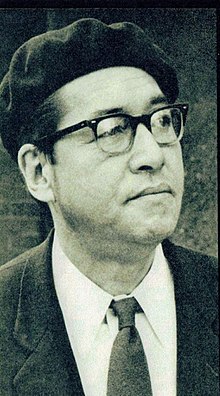Kōzaburō Yoshimura
Kōzaburō Yoshimura | |
|---|---|
 Yoshimura in 1967 | |
| Born | 9 September 1911 |
| Died | 7 November 2000 (aged 89) |
| Other names | Kimisaburo Yoshimura |
| Occupation | Film director |
| Years active | 1929-1974 |
Kōzaburō Yoshimura (吉村 公三郎, Yoshimura Kōzaburō, 9 September 1911 – 7 November 2000) was a Japanese film director.[1][2][3]
Biography
[edit]Born in Shiga Prefecture, he joined the Shōchiku studio in 1929.[2] He debuted as director with a short film in 1934, but, after being denied a promotion by head of the studio Shirō Kido,[4] continued working as an assistant director for filmmakers Yasujirō Ozu and Yasujirō Shimazu on films like Our Neighbor, Miss Yae and What Did the Lady Forget?[5] It was the 1939 film Warm Current that established his status as a director.[1][2][3] During the Sino-Japanese war he directed a number of military dramas such as The Story of Tank Commander Nishizumi (1940), for which he toured the actual battlefields in China.[6]
Yoshimura's 1947 The Ball at the Anjo House, starring Setsuko Hara, was named the best picture of the year by film magazine Kinema Junpo[1] and is regarded as one of his major works.[2][7] The film marked the start of a long relationship with screenwriter and film director Kaneto Shindō. In 1950, the two of them left Shōchiku and started the independent production company Kindai Eiga Kyōkai.[1][2] For his 1951 Clothes of Deception, produced by Daiei Film, Yoshimura received the Mainichi Film Award for Best Director.[8] Since the mid-1950s, Yoshimura's films were produced mostly by Daiei.[5]
Donald Richie and Joseph L. Anderson pointed out the lack of a cohesive visual style in Yoshimura's films, arguing that due to the wide range of material which Yoshimura chose, his style had to adopt to each individual film.[4] According to Richie and Anderson, the one distinguishable cinematic element of his later films was Yoshimura's quick editing.[4] The director's "most typical films" (Alexander Jacoby) were contemporary dramas focussing on sympathetically drawn female characters,[9] which earned him the comparison with Kenji Mizoguchi.[4][9]
Notable examples of Yoshimura's later work include Night River (1956), An Osaka Story (1957, a project he had taken over from Mizoguchi), Night Butterflies (1957) and Bamboo Doll of Echizen (1963).[2][4][9] He is credited with furthering the careers of actresses such as Fujiko Yamamoto, Ayako Wakao and his regular collaborator Machiko Kyō,[1] from whom he elicited outstanding performances.[9] In 1976, he received a Medal of Honor (Purple Ribbon) for artistic accomplishments.[1]
Selected filmography
[edit]Director
[edit]- Warm Current (暖流, Danryū) (1939)
- The Story of Tank Commander Nishizumi (1940)
- The Spy Isn't Dead Yet (1942)
- The Ball at the Anjo House (1947)
- Temptation (1948)
- Clothes of Deception (偽れる盛装, Itsuwareru seiso) (1951)
- The Tale of Genji (1951)
- Thousand Cranes (1953)
- Before the Dawn (1953)
- Ginza no onna (1955)
- Night River (1956)
- An Osaka Story (1957)
- Night Butterflies (1957)
- A Woman's Uphill Slope (女の坂, Onna no saka) (1960)
- A Woman's Testament (1960, episode "The Woman Who Forgot to Love")
- Bamboo Doll of Echizen (1963)
Producer only
[edit]- Epitome (1953)
- Life of a Woman (1953)
Legacy
[edit]A retrospective on Yoshimura and Kaneto Shindō was held in London in 2012, organised by the British Film Institute and the Japan Foundation.[7]
References
[edit]- ^ a b c d e f "Obituary: Kozaburo Yoshimura". The Japan Times. 8 November 2000. Retrieved 19 July 2023.
- ^ a b c d e f "吉村公三郎 (Yoshimura Kōzaburō)". Kotobank (in Japanese). Retrieved 4 December 2010.
- ^ a b "吉村公三郎 (Yoshimura Kōzaburō)". Kinenote (in Japanese). Retrieved 19 July 2023.
- ^ a b c d e Anderson, Joseph L.; Richie, Donald (1959). The Japanese Film – Art & Industry. Rutland, Vermont and Tokyo: Charles E. Tuttle Company.
- ^ a b "吉村公三郎 (Yoshimura Kōzaburō)". Japanese Movie Database (in Japanese). Retrieved 4 December 2010.
- ^ High, Peter B. (2003). The Imperial Screen. Wisconsin Studies in Film. The University of Wisconsin Press. pp. 211–217. ISBN 0-299-18134-0.
- ^ a b "Two Masters of Japanese Cinema: Kaneto Shindo & Kozaburo Yoshimura at BFI Southbank in June and July 2012" (PDF). Japan Foundation. Retrieved 18 July 2023.
- ^ "毎日映画コンクール 第5回(1950年)". Mainichi (in Japanese). Retrieved 21 July 2023..
- ^ a b c d Jacoby, Alexander (2008). Critical Handbook of Japanese Film Directors: From the Silent Era to the Present Day. Berkeley: Stone Bridge Press. ISBN 978-1-933330-53-2.
